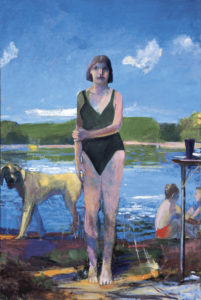Donald Beal: New Paintings
by Maureen Mullarkey
artcritical.com/2003/01/01/donald-beal-new-paintings
Donald Beal’s instinct for color is deeply appealing. And instinct it is. Color sense cannot be forced. It has to come of itself, rather as memories do, by natural association and unbidden, long after striving for it has ceased.
For the majority of contemporary painters, color precedes form. It is from color that forms are made. Painters committed to maintaining identifiable reference, however loose, to the world as it appears, must grant color a structural role. The finest of Beal’s work here maintains a subtle, lyrical balance between the constructive and expressive uses of color.
On show – Beal’s first at Prince Street- are a series of large explorations of the Provincetown Beech Forest. Played fortissimo, they are generous orchestrations of natural scenes that use color for its lyrical properties without losing touch with reality. Maura Coughlin’s comment in the exhibition brochure gets it just right in specifying the advantage of the subject to Beal’s coloristic approach:
The Beech Forest landscape is so much less sublime, much less easy to generalize: it shifts every footstep and changes with the seasons. It was without an obvious horizon, focal point or delineation between fore-, middle- and background, and Beal found it endlessly challenging, demanding its own complex visual language.
The language is simply that of color, seeded -in the most convincing works- with hard facts. It is for good reason that Woods, Dog and Rabbit was chosen for the announcement. Together with Dogwalker (Red Tree), this is Beal’s work at its most distinctive in terms of color and compositional discretion. Each of these uses the strong verticals provided by trees to stabilize the dappled disorder of sunlight and shade on woodland underbrush. In each, a spotted dog serves as a useful natural form for providing a needed neutralizing of high-keyed color rhymes.
Swamp and the over-sized [102 inches square, hung on the diagonal] Ladyslippers are lovely to look at. But color sensation is not the whole of painting. For me these are weakened by having surrendered too much to abstraction. In each of them, color spills across the surface, giving the effect of something vague waiting to be shaped. Pretty, painterly abstractions that abandon description have become commonplace. The differences between them, no matter the artist, are more rhetorical than visual. But Beal has an authentic gift for sustaining tension between a measured abstraction and visual truth. Why muffle the accomplishment?
The monumental Family Outing is quite different in feel and in influence. While the landscapes follow the chromatic lead of earlier colorists, this image of a standing woman seems more consciously contemporary. David Parks and Richard Diebenkorn are not far in the distance. It is an impressive painting if a bit unsettling. Color is more somber here, the rhyming gone. Its gritty modernity lends it a frisson that the subject itself might not suggest.
Donald Beal: New Paintings
by Maureen Mullarkey
Prince Street Gallery
530 West 25th Street, New York NY 10001
January 7 through 25, 2003
